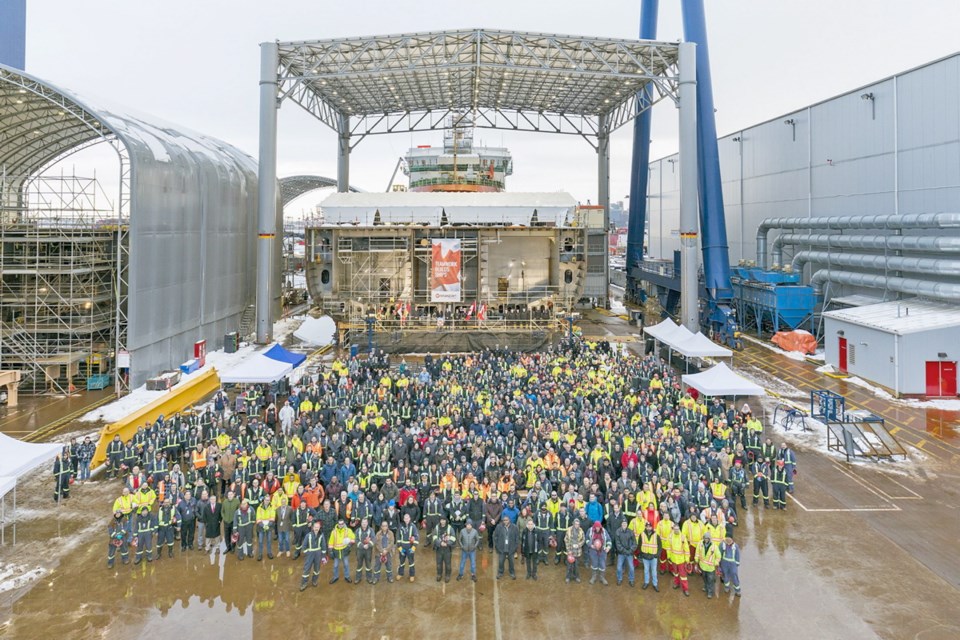The ceremonial keel-laying Thursday for what will become Canada’s largest naval ship signifies a key moment in the renewal of Canada’s military and will provide work for more than 1,000 shipyard employees for years, says Seaspan Shipyard.
The 173.7-metre-long vessel, to be named HMCS Protecteur, is the first of two federal joint support ships that Seaspan is building under the National Shipbuilding Strategy. Plans call for the first supply ship to be delivered in 2023.
“These warships will be strategic assets that will once again afford Canada the sovereign capacity to deliver — even in harms way — an enduring at-sea replenishment and joint sustainment capability as well as significant humanitarian assistance and disaster relief capacity,” Vice-Admiral Art McDonald, commander of the Royal Canadian Navy, said at the Seaspan yard in North Vancouver.
It will be the fourth vessel built by Seaspan under the national program.
Seaspan earlier delivered the Sir John Franklin and the Capt. Jacques Cartier offshore fisheries science vessels to the Canadian Coast Guard. A third offshore fisheries science vessel, to be named John Cabot, is scheduled to be delivered this summer.
When Seaspan won the right to negotiate contracts to build federal ships, it led to millions of dollars of investment to bolster B.C.’s shipyard sector and workforce. Shipyard training programs, supported by government and industry, have been established in Victoria and on the Lower Mainland.
Mark Lamarre, Seaspan Shipyards chief executive, said the scale of ship construction means “you need to build a workforce, an industry, a supply chain, and strong partnerships.”
The joint support ships will be the “largest naval ship ever built in Canada — a tremendous accomplishment for all the skilled and committed men and women involved in her design and construction,” Lamarre said.
The Protecteur will feature sophisticated damage control and self-defence systems that will allow it to conduct a full range of military operations in high-threat environments, a Seaspan statement said.
Along with the ability to provided at-sea replenishment, the multi-purpose warships will be able to integrate with Canadian or allied naval task groups, which will “significantly extend the range and endurance of these groups through the provision of fuel, ammunition, aviation support, food, spare parts, exercise and gym facilities and medical and dental care,” the statement said.
The new Protecteur replaces an earlier ship with the same name. The previous Protecteur was decommissioned in 2015 after it was heavily damaged as a result of an engine room fire in 2014. It had been on its way home to Esquimalt from Hawaii.
The other navy supply ship, HMCS Preserver, was removed from service that year because of its age.
In the meantime, Canada’s navy is using MV Asterix. The former tanker was converted to serve as an interim supply ship by Davie Shipyards in Quebec, to be used until the new supply ships are ready for service.
It is leased by the federal government from Federal Fleet Services, a private company. The Asterix was in Victoria in 2018 and again early last year, after supporting Canada’s navy in Asia Pacific waters.
The new joint support ships are being built in blocks.
Construction of the first blocks for the Protecteur began in June 2018. So far, 16 blocks are complete and another 37 blocks are under construction.
The first grand block was put together in November.
A grand block consists of four large ship blocks, comprising more than 160 tons of steel.
Once in service, the Protecteur will have a cruising speed of about 15 knots, a top speed of about 20 knots and a range of about 10,800 nautical miles.
Thursday’s ceremony saw a newly minted coin placed near the keel. The coin was put in place by 45-year Seaspan employee Jeff Smith.
The coin is said to bring good luck for the builders and all those who sail in the vessel, Seaspan said.
The coin features the crest of the future HMCS Protecteur on one side, and the crests/logos of the joint support project team on the back.



